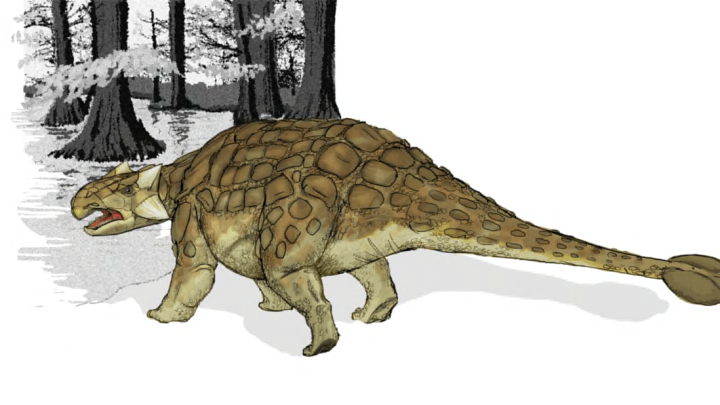Little craters on dinosaur bones aren’t necessarily battle scars from a death match. They might be signs of a less glamorous aspect of prehistoric life: festering infections.
Several years ago, a graveyard of more than 30 Gastonia ankylosaurs was discovered in Utah. When these tank-like dinosaurs died 125 million years ago, they left behind thousands of osteoderms—the bony plates of armor in their skin. Paleontologists noticed that the pieces of Gastonia armor were often marked with little pits and craters. One of the researchers, Kenneth Carpenter, curator at the Utah State University-Eastern Prehistoric Museum, said it was actually easy to tell that these weren’t bite marks.
“A pointed tooth puncturing a bone crushes and collapses the bone inward at the injury,” Carpenter told mental_floss. “This causes cracks to radiate outwards from the puncture. We did not seen any of these features on the ankylosaur armor.”
In a new study, published last month in the International Journal of Paleopathology, Carpenter and his colleagues tried to figure out what ailed the ankylosaurs by turning to a modern analog: crocodiles. The researchers looked over the literature on the bacterial infections, fungal infections, and other skin diseases than can leave traces in crocodile armor.
Without soft tissue, a conclusive diagnosis for the ankylosaurs wasn’t possible. But Carpenter and his colleagues think a likely explanation is that some of these dinosaurs had ulcerative dermatitis—which, among snake and reptile owners today, is better known as scale rot. (The squeamish—who should probably not watch this video—can at least take comfort in the fact that dinosaurs, like birds and reptiles, likely didn’t produce liquid pus, as the study authors note.) Dinosaur dermatitis probably formed from a bacterial or fungal infection, and possibly it was a secondary infection initiated by a bite from a blood-sucking parasite, the researchers said.
“In general, not much is known about disease in dinosaurs, because most of what we have are the bones,” Carpenter said, adding that paleontologists know “practically nothing” about dinosaur skin disease because the actual skin is rarely preserved. He is only aware of one example of direct evidence for an ulcerative dermatitis lesion in a dinosaur, preserved in an impression of hadrosaur skin that was display as a touch specimen in the Utah Museum of Natural History. (Because of its rarity, it has since been pulled from the touch display, Carpenter said.)
“Existing animals have these minor infections very commonly, like athletes foot in humans,” said Elizabeth Rega, a dinosaur disease expert at Western University of Health Sciences, who was not involved in the new study. Rega told mental_floss that researchers like herself are increasingly attributing these holes not to bites but to mundane infections.
“But,” she added, these explanations “are routinely ignored by the media whenever someone waves [their] arms about dinosaur bite marks, because combat is so much more fun.”
